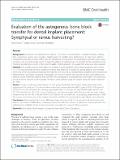Please use this identifier to cite or link to this item:
http://hdl.handle.net/11547/11593| Title: | Evaluation of the autogenous bone block transfer for dental implant placement: Symphysal or ramus harvesting? |
| Authors: | Ersanli, Selim |
| Keywords: | ILIAC CREST MANDIBULAR RAMUS |
| Issue Date: | 2016 |
| Series/Report no.: | 16; |
| Abstract: | Background: The absence of sufficient bone volume is the most relevant problem in implant dentistry. Grafting from exogenous sources may provide a limited gain but exhibits poor performance in large bone defects. Autogenous bone block transfer (ABBT) from the mandibular symphysis and ramus has been used with varying rates of success. The aim of this study was to compare the efficacy of symphysal and ramus ABBT for the restoration of lost horizontal alveolar bone volume in the anterior maxilla. Implants placed in the augmented areas were also evaluated. Methods: The maxillary alveolar bone deficits of 32 patients were treated by similar-sized autogenous bone blocks (7 x 7 x 4 mm) harvested from the symphysis or ramus area. After 4 to 5 months of healing, implants were inserted. At the end of the osseointegration period, the implants were restored by fixed prostheses. Baseline bone thickness was determined by Cone beam computed tomography and was compared to post-op and one-year post-loading bone thickness values where the implants were inserted. Any complications or consequences were noted. The success and survival of the 45 implants were evaluated. The results were analyzed using the Student t-test and Fisher's exact test (p < 0.05). Results: Post-op complications were frequent in both groups. Baseline bone thickness values were similar at the beginning of the study (p = 0.71) and exhibited a significant increase after the ABBT surgery (6.29 (SD 0.86) and 6.01 (SD 0.92) mm in the symphysis and ramus groups, respectively). The amount of bone thickness gain was 4.34 mm (SD: 0.92) and 4.36 mm (SD: 1.01) in the symphysis and ramus groups, respectively. After one year, the mean surface resorption was 0.6 mm (SD: 0.78) and 0.80 mm (SD: 0.56) for the symphysis and ramus groups, respectively (p = 0.089). The success and survival rates of the implants were 94.11 and 96.42 %, respectively. No graft failures were observed. Conclusions: Both symphysal and ramus ABBT procedures were successful for the restoration of a horizontal bone defect in the anterior maxilla. Ramus harvesting may be advisable due to fewer complications. Implants placed in the grafted regions exhibited a high success and survival rate within the one-year follow-up period. |
| URI: | http://hdl.handle.net/11547/11593 |
| ISSN: | 1472-6831 |
| Appears in Collections: | Web Of Science |
Files in This Item:
| File | Description | Size | Format | |
|---|---|---|---|---|
| s12903-016-0161-8.pdf | 1.3 MB | Adobe PDF |  View/Open |
Items in DSpace are protected by copyright, with all rights reserved, unless otherwise indicated.
